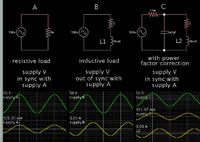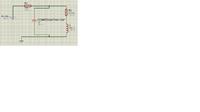KhaledOsmani
Full Member level 6
Try 20 to 200 uF as a likely range for pfc capacitors. Notice the C value in my simulation. (24.7 uF)
The website below examines an inductive load of several A, and calculates a value of 80 uF for pfc.
https://www.allaboutcircuits.com/te...nt/chpt-11/practical-power-factor-correction/
In simulation a small change can move the Ampere waveform several degrees. Suppose I start with a new load. The Ampere zero crossing wants to remain at a 'pinned' condition of 90 deg lagging or 90 deg leading. I usually need to try many C values, before I can find a range where I can make the Ampere waveform shift left and right, in relationship to the Voltage waveform.
By the way, I spoke the wrong way around in post #336, regarding current waveform advancing with inductive load, retreating with pfc capacitor.
Brad,
If 6uF over-compensated the motor, and made it draw more current, how is it supposed to act when having a shunt of 20uF and more?!

